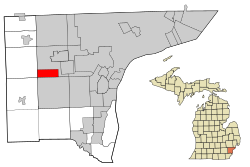Wayne, Michigan
| Wayne, Michigan | ||
|---|---|---|
| City | ||
| City of Wayne | ||
|
||
 Location in Wayne County and the state of Michigan |
||
| Coordinates: 42°16′41″N 83°22′43″W / 42.27806°N 83.37861°W | ||
| Country | United States | |
| State | Michigan | |
| County | Wayne | |
| Government | ||
| • Mayor | Susan Rowe | |
| Area | ||
| • Total | 6.02 sq mi (15.59 km2) | |
| • Land | 6.02 sq mi (15.59 km2) | |
| • Water | 0 sq mi (0 km2) | |
| Elevation | 656 ft (200 m) | |
| Population (2010) | ||
| • Total | 17,593 | |
| • Estimate (2012) | 17,310 | |
| • Density | 2,922.4/sq mi (1,128.3/km2) | |
| Time zone | EST (UTC-5) | |
| • Summer (DST) | EDT (UTC-4) | |
| ZIP code | 48184 | |
| Area code(s) | 734 | |
| FIPS code | 26-84940 | |
| GNIS feature ID | 1615901 | |
| Website | http://www.ci.wayne.mi.us/ | |
Wayne is a city in Wayne County in the state of Michigan, west of Detroit. As of the 2010 census, the city population was 17,593. Wayne has a long history of automotive and transportation related manufacturing. Ford Motor Company currently has two plants here; Wayne Stamping & Assembly and the Michigan Assembly Plant, formerly known as the Michigan Truck Plant.
The site of Wayne was crossed by the Sauk Trail, and due to this, the area was visited by Potawatomi and French fur traders for years before permanent settlement. The first settler was George M. Johnson, who built a small log cabin on 80 acres of land in 1824 (a state historical marker can now be found at the site). The cabin served as a tavern for travelers along the trail, by then known as the Chicago Road. The area soon became known as Johnson's Tavern. After a few years, the tavern was sold to Stephen G. Simmons, who continued to operate the business until he murdered his wife while in a drunken rage. Simmons was arrested and taken to Detroit, where he was tried and hanged September 24, 1830. He became the last person to be executed in Michigan, as the territory abolished capital punishment shortly thereafter.
In 1832, Ezra Derby bought the tavern and land from the Simmons heirs and began establishing a settlement. Derby built a sawmill, store, mill, blacksmith shop and the first frame dwelling for himself. In 1834 a plat was recorded in Detroit with lots and a town square under the name Derby's Corners. In 1836, the name of the settlement was changed to Wayne, in honor of Revolutionary War General Anthony Wayne. Soon a small hamlet began to develop, which was accelerated by the arrival of the Michigan Central Railroad in 1838. The Chicago Road that ran through Wayne was paved with oak logs in 1850, becoming the Detroit and Saline Plank Road. In 1867 it was changed to its current name of Michigan Avenue. In 1869, Wayne was incorporated as a village with a population of about 800 people. (In 1960 Wayne officially became a city.)
...
Wikipedia

